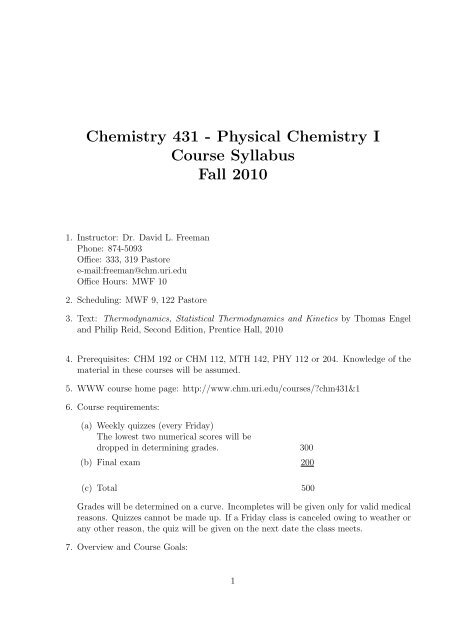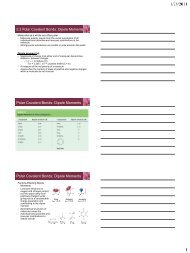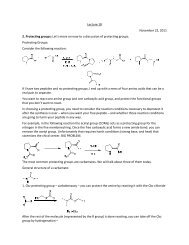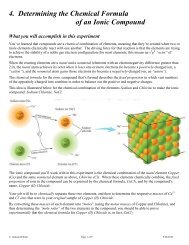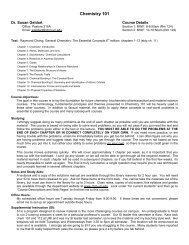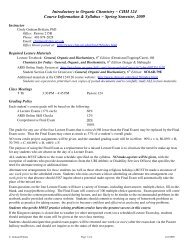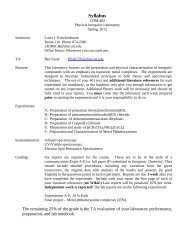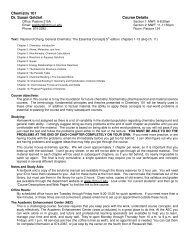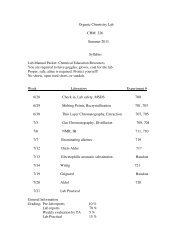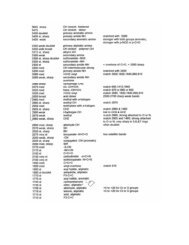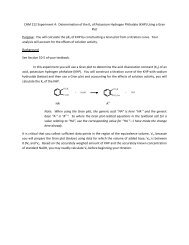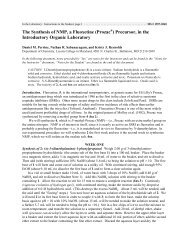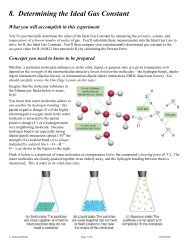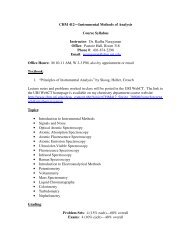Chemistry 431 - Physical Chemistry I Course Syllabus Fall 2010
Chemistry 431 - Physical Chemistry I Course Syllabus Fall 2010
Chemistry 431 - Physical Chemistry I Course Syllabus Fall 2010
Create successful ePaper yourself
Turn your PDF publications into a flip-book with our unique Google optimized e-Paper software.
<strong>Chemistry</strong> <strong>431</strong> - <strong>Physical</strong> <strong>Chemistry</strong> I<br />
<strong>Course</strong> <strong>Syllabus</strong><br />
<strong>Fall</strong> <strong>2010</strong><br />
1. Instructor: Dr. David L. Freeman<br />
Phone: 874-5093<br />
Office: 333, 319 Pastore<br />
e-mail:freeman@chm.uri.edu<br />
Office Hours: MWF 10<br />
2. Scheduling: MWF 9, 122 Pastore<br />
3. Text: Thermodynamics, Statistical Thermodynamics and Kinetics by Thomas Engel<br />
and Philip Reid, Second Edition, Prentice Hall, <strong>2010</strong><br />
4. Prerequisites: CHM 192 or CHM 112, MTH 142, PHY 112 or 204. Knowledge of the<br />
material in these courses will be assumed.<br />
5. WWW course home page: http://www.chm.uri.edu/courses/chm<strong>431</strong>&1<br />
6. <strong>Course</strong> requirements:<br />
(a) Weekly quizzes (every Friday)<br />
The lowest two numerical scores will be<br />
dropped in determining grades. 300<br />
(b) Final exam 200<br />
(c) Total 500<br />
Grades will be determined on a curve. Incompletes will be given only for valid medical<br />
reasons. Quizzes cannot be made up. If a Friday class is canceled owing to weather or<br />
any other reason, the quiz will be given on the next date the class meets.<br />
7. Overview and <strong>Course</strong> Goals:<br />
1
<strong>Physical</strong> chemistry is the study of the application of the principles of physics to chemical<br />
phenomena. In a simple sense, we can think of physical chemistry as subdivided<br />
into three topics: thermodynamics, quantum mechanics and kinetics. In reality, these<br />
subtopics are interrelated, and it is a goal of both CHM <strong>431</strong> and CHM 432 for you to<br />
appreciate the relations.<br />
<strong>Physical</strong> chemistry has the reputation of being a hard course. It is my feeling that the<br />
difficulties faced by third year students trying to learn physical chemistry arise from<br />
the large set of topics that must be mastered. Additionally, many of the topics that<br />
are covered are inherently abstract. This abstraction of chemical phenomena is not<br />
easy, and a major course goal for this year is to understand how the laws of physics<br />
enable us to understand the principles of chemistry in an abstract way.<br />
Although physical chemistry is difficult, there is a way to be successful in this course.<br />
It is imperative that you do homework. Problem sets will be distributed about once a<br />
week, and the homework problems will be representative of the kinds of questions you<br />
will be given on the examinations. Solutions to the problem sets will be distributed<br />
in class. It is important that the homework be completed before the solutions are<br />
distributed for you to gain adequate practice with the material. It is to be emphasized<br />
that understanding solutions to a problem with the solution sets is not difficult. The<br />
initiation of solutions to problems is difficult, and you will be asked to initiate solutions<br />
on examinations.<br />
This semester we will be concerned with the principles that govern the macroscopic<br />
behavior of chemical systems. These principles are contained in the laws of thermodynamics.<br />
Our principle goal for CHM <strong>431</strong> is to understand the three laws of thermodynamics<br />
and how to apply the laws to chemical systems.<br />
The thermodynamic laws we shall learn are only valid for systems at equilibrium. The<br />
thermodynamic laws provide the basis for the rationalization of equilibrium phenomena,<br />
including both phase and chemical equilibria. Understanding the thermodynamic<br />
basis of equilibrium is our third course goal.<br />
8. The CHM <strong>431</strong> Web page:<br />
In this course all problem sets, problem set solutions, quiz solutions and final exam<br />
solutions are to be distributed on the course web page. No paper copies of the problem<br />
sets are to be distributed. The URL of our course web page is<br />
http://www.chm.uri.edu/courses/chm<strong>431</strong>&1 . It is strongly suggested that you link<br />
to our web page to obtain the first problem set as soon as possible. If you have no web<br />
access, please see Dr. Freeman who can arrange web access for you.<br />
It is expected that for most of you, success in this course will require some level of<br />
help beyond classroom instruction. Because some of you may find it difficult to come<br />
to the scheduled office hours, we have installed as part of our course web pages, a page<br />
that can be used to submit questions. Questions are submitted by anyone in the class<br />
by filling out a form on the web page, and answers are distributed either to the entire<br />
2
class or only to the person asking the question. If the entire class is to receive a copy<br />
of the question and answer, the question is treated as anonymous; i.e. the person who<br />
asks the question is never identified. In fact, it is possible to submit a question so that<br />
even the instructor does not know who submitted the question. Anonymous questions<br />
and responses by the instructor are distributed automatically to everyone who has<br />
submitted their e-mail address to the instructor. With ordinary electronic mail, there<br />
is a private correspondence between the student and instructor. By using the web<br />
page, the entire class has an opportunity to learn from the questions submitted.<br />
The use of the web page does not preclude personal interaction between any of you and<br />
the course instructor. Dr. Freeman has regular office hours, and you are all encouraged<br />
to make use of these hours. Alternate meeting times can be arranged by appointment.<br />
Additionally, you can contact Dr. Freeman by e-mail or telephone. The e-mail address<br />
and phone number for Dr. Freeman is given on the first page of this syllabus.<br />
To receive copies of the submitted questions and the answers to the questions, you<br />
must submit your e-mail address. To submit your e-mail address, go to our home<br />
page (http://www.chm.uri.edu/courses/chm<strong>431</strong>&1) and click on “Subscribe to the<br />
CHM <strong>431</strong> list.” On the resulting form, enter your e-mail address, click on the small<br />
“subscribe” button and then click on the submit button. You can also use this form<br />
to unsubscribe from the list in case you drop CHM <strong>431</strong>.<br />
Any student in CHM <strong>431</strong> can submit questions and comments to Dr. Freeman. Submission<br />
of such comments or questions must be made using the WWW home page for<br />
this course. The address (URL) of our home page is<br />
http://www.chm.uri.edu/courses/chm<strong>431</strong>&1 . To submit a question to the list, you<br />
must click on the highlighted text that says “submit a question to the CHM <strong>431</strong> list.”<br />
As an example of how to use the list, suppose a student in our class, Ms. Benzene<br />
Ring, wonders, “Is work a path or a state function” (If you don’t know what this<br />
means, don’t worry. You will understand the question early in the semester). To obtain<br />
an answer to her question, Ms. Ring links her web browser (e.g. Firefox, Safari<br />
or Microsoft Internet Explorer) to http://www.chm.uri.edu/courses/chm<strong>431</strong>&1, and<br />
she then clicks on the text linking her to the page for questions (i.e. the highlighted<br />
text that says “submit a question to the CHM <strong>431</strong> list”). Ms. Ring then enters her<br />
e-mail address in the appropriate box and specifies whether she wants her question to<br />
be answered to the entire CHM <strong>431</strong> class or to her alone. Ms. Ring then types in the<br />
large box<br />
Is work a path or a state function<br />
Ms. Ring then clicks the “send” button. Ms. Ring’s question is received by Dr. Freeman.<br />
Dr. Freeman then sends an e-mail message to the whole list that might be<br />
Subject: work<br />
The question is: The question is: Is work a path or a state function<br />
Answer: Work is a path function.<br />
3
Now Ms. Ring and the entire class have an answer to her question.<br />
If the answer to the question can be sent to the entire list, the answer will not indicate<br />
who asked the question. If Ms Ring wants to ask the question with full anonymity so<br />
that even Dr. Freeman has no idea who asked the question, the e-mail portion of the<br />
form can be left blank. Of course, if the e-mail section of the form is blank, the answer<br />
must be sent to the list and not just to the sender.<br />
Because many questions may contain mathematical formulas, we need a notation to<br />
communicate the special symbols used in the course. To avoid confusion, it is most<br />
useful if we agree on the same set of symbols. The symbols that follow are taken<br />
from a language called L A TEX. L A TEX is a language that is frequently used to prepare<br />
scientific documents, and L A TEX can be used to translate special symbols into simple<br />
text characters. By learning L A TEX notation, you will learn a widely used method<br />
to communicate mathematical symbols via e-mail. The instructor plans to use these<br />
symbols in answering your questions, and it is asked that you use the same symbols in<br />
posing questions. The most important symbols are the following:<br />
(a) Greek letters are represented by \ followed by the name of the letter. For example<br />
α is typed \alpha, β is typed \beta, and so on. A Greek letter is made upper<br />
case by making the first letter of its name upper case. For example, the letter ∆<br />
is typed \Delta.<br />
(b) Subscripts are represented by {} where the brackets contain the subscripts. For<br />
example, µ ij is typed \mu {ij}.<br />
(c) Superscripts are represented by ˆ{} where the brackets contain the superscripts.<br />
For example, β 12 is typed \beta ^{12}.<br />
(d) Infinity (∞), is typed \infty.<br />
(e) The integral sign ∫ is typed \int. The limits on a definite integral are included<br />
by introducing subscripts and superscripts. As an example ∫ ∞<br />
0 e −x2 dx is typed<br />
\int {0} ^{\infty} e ^{-x ^{2}} dx.<br />
(f) The partial derivative symbol ∂ is typed \partial.<br />
(g) The summation sign ∑ is typed \sum. The lower and upper limits of summation<br />
are included as subscripts and superscripts. As an example ∑ ∞<br />
n=0 1/n 2 is typed<br />
\sum {n=0} ^{\infty} 1/n ^{2}.<br />
(h) Square roots √ a + b are typed \sqrt{a+b}.<br />
(i) The arrow in chemical reactions → is typed --->. For example C+O 2 → CO 2 is<br />
typed C + O {2} ---> CO {2}.<br />
Let us now look at another example of a question submitted using the web. In this<br />
case, Ms. Ring has a question requiring an equation. This might be a real question.<br />
If you don’t understand the context, don’t worry. You will understand the details of<br />
4
the question later in the course. Suppose Ms. Ring wants to ask<br />
“In deriving the expression for the phase equilibrium line between solid and liquid,<br />
when evaluating the integral expression<br />
p 2 − p 1 =<br />
∫ T2<br />
T 1<br />
∆H<br />
T ∆V dT<br />
the ratio of ∆H to ∆V is taken outside the integral. What is the justification for this”<br />
To submit the question, Ms. Ring uses her web browser to attach to<br />
http://www.chm.uri.edu/courses/chm<strong>431</strong>&1, clicks on the line that says, “submit a<br />
question to the CHM <strong>431</strong> list,” and then Ms. Ring enters the information requested<br />
by the form. If Ms. Ring wishes to remain anonymous, Ms. Ring leaves the e-mail<br />
box blank. Ms. Ring then types into the large box<br />
In deriving the expression for the phase equilibrium line between solid and<br />
liquid, when evaluating the integral expression<br />
p {2}-p {1}=\int {T {1}} ^{T {2}} \Delta H/T\Delta V dT the ratio of \Delta H<br />
to \Delta V is taken outside the integral. What is the justification for<br />
this<br />
and clicks on the submit button. Ms. Ring’s question is received by Dr. Freeman.<br />
The answer will be sent either to Ms. Ring alone, or preferably to the entire class if<br />
the appropriate box is checked. Dr. Freeman might reply<br />
Subject: Phase equilibrium question<br />
The question is:In deriving the expression for the phase equilibrium line<br />
between solid and liquid, when evaluating the integral expression<br />
p {2}-p {1}=\int {T {1}} ^{T {2}} \Delta H/T\Delta V dT the ratio of \Delta H<br />
to \Delta V is taken outside the integral. What is the justification for<br />
this<br />
The answer is: For solids and liquids the ratio \Delta H/\Delta V is only<br />
weakly dependent on temperature. The ratio, then, can be taken outside the<br />
integral to a good approximation.<br />
Remember, your first task is to subscribe to the CHM <strong>431</strong> list by filling out the form<br />
on our web pages. You can then send questions and comments to Dr. Freeman using<br />
your web browser starting at the URL<br />
http://www.chm.uri.edu/courses/chm<strong>431</strong>&1<br />
9. <strong>Course</strong> outline:<br />
5
Topic<br />
Book Chapter<br />
1. Energy and Work<br />
2. Thermodynamic Systems and the Ideal Gas Law 1<br />
3. Heat, Work and the First Law 2<br />
4. State Functions and Some Mathematics for Thermodynamics 3<br />
5. Thermochemistry 4<br />
6. The Second and Third Laws 5 (Skip Sec. 5.11-5.14)<br />
7. The Free Energy Functions and Chemical Equilibrium 6, 5.12<br />
8. Real Fluids 7<br />
9. Phase Transitions in One-component Systems 8<br />
10. Ideal and Real Solutions 9<br />
11. Electrolyte Solutions 10<br />
12. Electrochemistry 11<br />
16. Final Exam Comprehensive<br />
6


